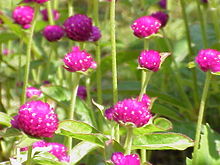Subfamily of flowering plants
The Gomphrenoideae are a subfamily of the Amaranthaceae.
The stamens have anthers with only one lobe (locule) and two pollen sacs. Many species show C4-photosynthesis pathway.[1]
The center of diversity lies in Central America, Mexico and the dry forests and thorn bush savannas of South America.[2]
Systematics
The subfamily Gomphrenoideae was first published in 1893 by Hans Schinz (in: Engler und Prantl (Eds.): Die Natürlichen Pflanzenfamilien vol. 3, 1a, p. 97).
According to phylogenetic research by Sanchez Del-Pino (2009), the subfamily Gomphrenoideae Schinz is regarded as a monophyletic taxon with 19 genera and about 300-400 species. The traditional classification with two tribes (Gomphreneae and Pseudoplantageae) does not reflect the phylogenetic relationship in this group. Three clades can be recognized.:[1]
Iresinoids
- Irenella Suess., with only one species:
- Irenella chrysotricha Suess., in rain forests of Ecuador. Phylogenetically, it falls within Iresine.
- Iresine P.Browne (Syn.: Dicraurus Hook. f.): with about 45 species in North and South America.
- Woehleria Griseb.: with only one species
- Woehleria serpyllifolia Griseb., on mountain coasts of Cuba. Phylogenetically, it falls within Iresine.
This is the sister clade of the two other clades.
Alternantheroids
- Alternanthera Forssk. (Syn.: Brandesia Mart.): with about 100-200 species, mainly in America, also in Africa and Australia.
- Pedersenia Holub: with about 10 species in tropical America.
- Tidestromia Standl.: with about 6 species in deserts of southern North America.
C4 carbon fixation evolved independently in the genera Alternathera, which also contains C3 and C3–C4 intermediate species, and Tidestromia.[3][4]
Gomphrenoids
- Blutaparon Raf. (Syn.: Philoxerus R.Br.): with about 5 species at shores of North and Middle America, West Africa, Micronesia and Japan, for example:
- Froelichia Moench: with about 12 species in America.
- Froelichiella R.E.Fr., with only one species:
- Froelichiella grisea R.E.Fr. in Brasília.
- Gomphrena L. (Syn.: Bragantia Vand.): with about 90 species in America and about 30 species in Australia. This genus is polyphyletic, so taxonomical changes have to be expected.[1]
- Gossypianthus Hook.: with 2 species in southern North America.
- Guilleminea Kunth (Syn.: Brayulinea Small)
- Hebanthe Mart.: with about 7 species in tropical America.
- Hebanthodes Pedersen, with only one species:
- Hebanthodes peruviana Pedersen in Peru.
- Lithophila Sw., with 2 species on Galapagos and the Caribic
- Pfaffia Mart.: with about 35 species in tropical America.
- Pseudogomphrena R.E.Fr.,with only one species:
- Pseudogomphrena scandens R.E.Fr. in Brasília.
- Pseudoplantago Suess.: with one species in Venezuela and one in Argentina.
- Quaternella Pedersen: with 3 species in Brasília.
- Xerosiphon Turcz.: with about 2 species in Brasília.
One large clade within this group, containing the genera Froelichia, Guilleminea, Blutaparon, some Gomphrena species, and probably Gossypianthus and Lithophila, has acquired the C4 carbon fixation pathway.[3][4] Some of these C4 species occur at unusually high altitudes in the Andes, in cooler conditions than their C3 relatives.[5]





